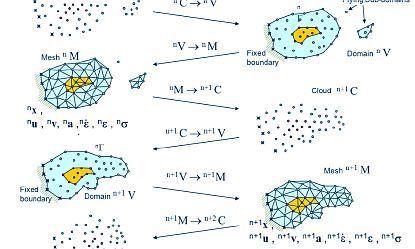
 Advances in the Particle Finite Element Method (PFEM) for Multidisciplinary Problems in Engineering
Advances in the Particle Finite Element Method (PFEM) for Multidisciplinary Problems in Engineering
Eugenio Oñate
Technical University of Catalonia (UPC) – SPAIN
Curriculum
Prof. EUGENIO OÑATE, Civil Engineer by the Technical University of Valencia, Spain (1975) and Ph.D. by the University of Swansea, Wales, UK (1979), Director of the School of Civil Engineering of Barcelona (1983-89), Director of the International Center for Numerical Methods in Engineering (CIMNE) of the Technical University of Catalonia (since 1987), Honorary President of the Spanish Society of Numerical Methods in Engineering (SEMNI) (since 2004), Past-President of the European Community on Computational Methods in Applied Sciences (ECCOMAS) (2000-2004) and Past-President of the International for Association Computational Mechanics (IACM) (2002-2010). He has received a number of awards from universities and scientific and technological organizations worldwide. He is author of some 262 scientific papers on developments and applications of finite element and particle-based methods for structural and geomechanical problems, fluid dynamics and industrial forming processes.
Abstract
We present recent developments in the the Particle Finite Element Method (PFEM, www.cimne.com/pfem) for analysis of complex coupled problems in engineering accounting for fluid-soil-structure interaction (FSSI) and coupled thermal effects. The PFEM uses an updated Lagrangian description to model the motion of nodes (particles) in both the fluid and the structure domains which are modelled as a single continuum. Nodes are viewed as material points which can freely move and even separate from the main analysis domain representing, for instance, the effect of water drops or excavated material. A mesh connects the nodes defining the discretized domain where the governing equations for the unified FSSI problem are solved as in the standard FEM. The necessary stabilization for dealing with the incompressibility of the fluid is introduced via the finite calculus (FIC) method. An incremental iterative scheme for the solution of the non linear transient coupled FSSI problem is used. Advances in the PFEM to allow for frictional contact conditions and surface erosion at fluid-solid and solid-solid interfaces via mesh generation are described. We present examples of application of the PFEM to a number of coupled problems such as the effect of waves and water streams on civil and naval structures, the stability of earth dams in overtopping situations, the large motions of floating and submerged bodies, the impact of slurry flows on structures, the erosion due to water streams in river beds and slopes, excavation and drilling problems in the construction and oil/gas industries, the melting and dripping of objects under the effect of fire and the simulation of industrial forming problems,among others.

